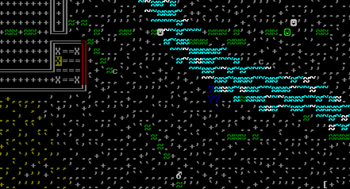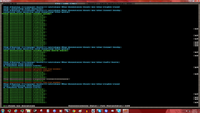- v50 information can now be added to pages in the main namespace. v0.47 information can still be found in the DF2014 namespace. See here for more details on the new versioning policy.
- Use this page to report any issues related to the migration.
Difference between revisions of "DF2014:Vomit"
LethosorBot (talk | contribs) (LethosorBot moved page DF2014:Vomit to Vomit: Migrating v50 page (4378/4618) (content)) Tag: New redirect |
LethosorBot (talk | contribs) (Migrating v50 page (4378/4618) (content)) Tag: Removed redirect |
||
| Line 1: | Line 1: | ||
| − | + | {{Quality|Superior|22:47, 26 April 2014 (UTC)}} | |
| + | {{av}} | ||
| + | [[Image:Vomit_Trail.png|thumb|right|350px|Both vomit and [[DF2014:Finished goods|useless crap]] are common markers of a dwarf trail on the surface.]] | ||
| + | Under certain conditions, [[creature]]s (such as your [[dwarf|dwarves]]) will '''vomit''', creating a [[contaminant|puddle of vomit]]. This may occur from an injury to an organ (usually the stomach, pancreas, and such), or from [[cave adaptation]]. Vomiting does not seem to create an unhappy thought ("nauseated by the sun" is from cave adaptation). Eating too much in [[adventurer mode]] will cause an adventurer to vomit. After vomiting once, a creature will begin to retch, bringing up nothing. The retching will continue in place of vomiting until the creature eats again. For example, dwarves that have been stationed for too long without food or water will occasionally eat vomit, causing an unhappy thought. | ||
| + | |||
| + | [[Titan]]s, [[forgotten beast]]s, and [[demon]]s are occasionally made of vomit, though, unless paired with a dangerous attack, these creatures are relatively weak, due to vomit being a liquid and therefore extremely fragile. | ||
| + | |||
| + | {{clear}} | ||
| + | |||
| + | == Bugs == | ||
| + | [[File:Too_much_throw_up.png|thumb|200px|{{bug|3562|link=yes}} also applies to animals]] | ||
| + | * An adventurer injured in the guts can continuously vomit even after fast travel. {{bug|3562}} | ||
| + | * Pools (including vomit) can multiply excessively. {{bug|296}} | ||
| + | * Vomit can become laced with water multiple times. {{bug|257}} | ||
| + | |||
| + | {{Translation | ||
| + | | dwarven = ôggon | ||
| + | | elvish = cemato | ||
| + | | goblin = strastnas | ||
| + | | human = sethbap | ||
| + | }} | ||
| + | |||
| + | {{gamedata|{{raw|DF2014:hardcoded_materials.txt|MATERIAL|VOMIT}}}} | ||
| + | {{materials}} | ||
| + | |||
| + | {{Category|Materials}} | ||
| + | [[ru:Vomit]] | ||
Latest revision as of 04:06, 20 December 2022
| This article is about an older version of DF. |

Under certain conditions, creatures (such as your dwarves) will vomit, creating a puddle of vomit. This may occur from an injury to an organ (usually the stomach, pancreas, and such), or from cave adaptation. Vomiting does not seem to create an unhappy thought ("nauseated by the sun" is from cave adaptation). Eating too much in adventurer mode will cause an adventurer to vomit. After vomiting once, a creature will begin to retch, bringing up nothing. The retching will continue in place of vomiting until the creature eats again. For example, dwarves that have been stationed for too long without food or water will occasionally eat vomit, causing an unhappy thought.
Titans, forgotten beasts, and demons are occasionally made of vomit, though, unless paired with a dangerous attack, these creatures are relatively weak, due to vomit being a liquid and therefore extremely fragile.
Bugs[edit]

- An adventurer injured in the guts can continuously vomit even after fast travel. Bug:3562
- Pools (including vomit) can multiply excessively. Bug:296
- Vomit can become laced with water multiple times. Bug:257
"Vomit" in other Languages
|
Raws |
|---|
[MATERIAL:VOMIT] - reconstructed from data extracted from memory
[STATE_COLOR:ALL:DARK_GREEN]
[STATE_NAME_ADJ:ALL_SOLID:vomit]
[STATE_NAME_ADJ:SOLID_PRESSED:pressed vomit]
[BASIC_COLOR:2:0]
[BUILD_COLOR:2:0:0]
[TILE_COLOR:7:7:1]
[SPEC_HEAT:4181]
[HEATDAM_POINT:10180]
[SOLID_DENSITY:1200] |
| More: Gems • Metals • Stones | |
| Creature | |
| Plant | |
| Creature/Plant | |
| Inorganic |
Metal • Milk of lime • Soil (Clay • Sand) • Stone (Ash glaze • Earthenware • Gem • Gypsum plaster • Porcelain • Quicklime • Stoneware • Tin glaze) |
| Hardcoded | |
| See also: Material science | |